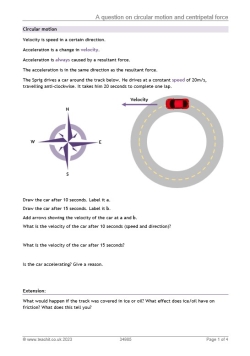A question on circular motion and centripetal force

A simple question in the style of the GCSE physics or combined science exam, and gap-filling tasks, to support a first lesson on circular motion and centripetal force at key stage 4.
After a reminder of the definitions of velocity and acceleration, students answer a question about a car following a circular path around a racetrack at a constant speed. They draw the car after 10 seconds and 15 seconds, add arrows, calculate its velocity and state whether or not it is accelerating. In an extension question, they have the opportunity to consider the effect of reduced friction (causing the car to skid).
In the second part of the worksheet, students complete a definition of centripetal force. They then consider some examples of centripetal force and state what type of force is involved, such as gravitational force in a satellite orbiting Earth. Finally, they consider the factors that affect centripetal force, such as the radius of the circle.
Answers are included.
The definition of centripetal force from this worksheet:
- An object travelling in a circle is always accelerating towards the centre.
- This is called centripetal acceleration and is caused by a resultant force.
- Centripetal force = any resultant force that makes an object move in a circle.
